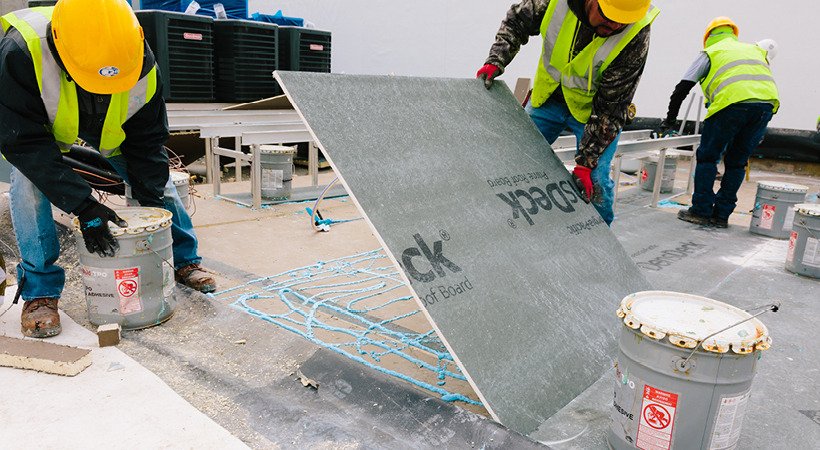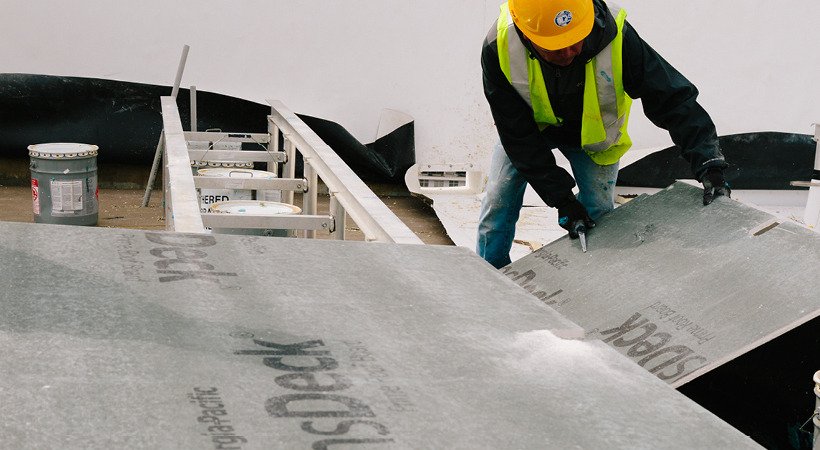Roof Design for Higher Education: Why You Should Consider Cover Board

Higher education has faced many challenges in recent years. The pandemic, a shifting labor market, hybrid learning and a decrease in enrollment have all made securing funding even more difficult. Furthermore, technology is changing the way that schools and spaces in general need to be designed—as has the push for sustainability. Architects must also design for safety while keeping spaces attractive and conducive to learning.
A resilient roof design that includes gypsum cover board can help higher education buildings maximize their return on investment by mitigating roof damage and increasing longevity. Plus, a rigid substrate can help prepare buildings for future demands like solar roofs, green roofs and other heavy equipment. All of which helps keep students and occupants safe and focused on learning.
The Purpose of Cover Board
When used on low-slope roofs like those of commercial buildings and schools, a cover board can help mitigate the risks of moisture damage, fire, wind uplift and puncture damage. This is important for higher-education buildings, especially those that incorporate green design measures such as photovoltaic (solar) and vegetative roofs. A strong mat-to-core bond can help provide a rigid substrate to support these types of rooftop enhancements, while the non-combustible gypsum core can help slow the spread of flames and smoke in the event of a fire.
A durable cover board can also help with sound abatement, which is particularly important in schools. Adding a layer of high-density material between the insulation and roofing membrane has a significant effect on the STC (Sound Transmission Class) rating. Cover board can reduce the decibels of outside noise that reach occupants inside of the building, helping to minimize distractions.

Combatting the Threat to a Roof’s Life Span
Roofing Consultants ranked puncture as the top threat to a roof’s life span in a survey by Ducker Worldwide in 2016. Moisture damage, fire, wind, foot traffic and hail also ranked as threats.
Using a cover board can increase a roof’s life expectancy by six to seven years on average.¹ This provides a significant return on investment for building owners. While cover boards are an initial up-front investment, they can help a roof’s “dollar per life expectancy year” decrease. The yearly cost savings can be significant—more than $5,000 per year, or roughly $129,000 of service life savings.
Recommendations and Key Approvals
You can verify the quality and reputation of products and materials by seeing if they’ve been recommended by professional organizations, or if they’ve achieved third-party approvals or certifications. Since the 1970s, the National Roofing Contractor’s Association (NRCA) has recommended cover boards for low-slope commercial roofs. Around the year 2000, the Canadian Roofing Contractors Association (CRCA) and the Midwest Roofing Contractors Association (MRCA) joined in. Today, cover boards are also recommended by the Whole Building Design Guide (WBDG), the Insurance Institute for Business & Home Safety (IBHS), and the American Institute of Architects.
There are also different kinds of approvals or certifications a cover board may or may not hold. These approvals come from certifiers like UL or Underwriter Laboratories, a third-party certification company founded in 1894. UL certifies products that are specific to fire with the aim of making the world a safer place for both workers and consumers.
Another third-party certifier of cover boards is FM Global. As an insurer, FM Approvals’ product testing and certification program includes comprehensive testing with standards that focus on loss prevention.

Building Performance and Durability
A durable roof designed with quality materials can enable schools to maximize their ROI by mitigating the risk of roof damage. In addition to protecting students and occupants, resilient roofs can help future-proof buildings for enhancements like:
- Solar panels
- Green roofs
- Cell towers
- New technology
- Heavy equipment
Learn more by taking the AIA webinar here. Or, visit buildgp.com/densdeck.
1 Third-party survey by Ducker Worldwide, October 2016.